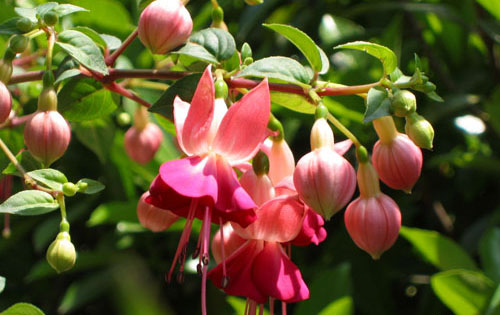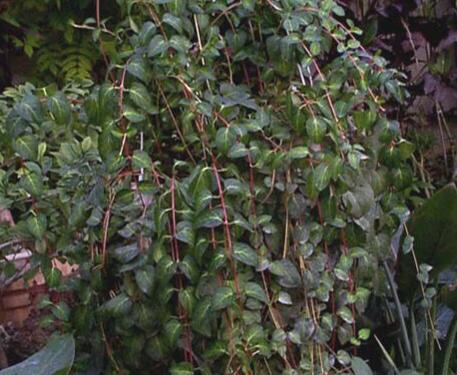How is the incidence of root rot in Jinzhong upside down?
Root rot is a physiological disease that hangs the golden bell upside down. Jinzhong upside down like cool, moist, semi-overcast, well-ventilated environment, not resistant to hot and hot, avoid hot and stuffy heat. The suitable temperature for growth is 15 to 25 degrees, and when the temperature exceeds 30 degrees, it enters a semi-dormant state.
In maintenance, improper management of water and fertilizer can easily lead to rotten roots. Too much watering after summer, especially in the midsummer season, when the temperature is more than 30 degrees, when the golden bell is dormant or semi-dormant, metabolic activity is weak, water and fertilizer are very little.
If too much water is watered at this time, the water fills the soil gap, causing hypoxia, and it is very easy to cause rotten roots, at the same time, if you continue to apply fertilizer, it is also very easy to cause the roots to blacken and rot.
After the roots of the golden bell were hung upside down, the branches and leaves of the light ones wilted, affecting the flowering, and the heavy ones died of the whole plant. It is mainly caused by Pythium, which is easy to occur when the water content of basin soil is too large.

Inverted Golden Bell Botrytis cinerea rotten Root
Occurs on leaves, stems and flowers. The edge of the diseased leaf produces brown disease spot, the surface appears wheel-like wrinkle, when it is wet, the disease spot is covered with gray mildew, that is, pathogen conidia. After the stem and bud is damaged, it produces purple-brown disease spot, soft rot and gray mold, which makes the stem and bud rot. The pathogen is Botrytis cinerea of half-known fungi and Botrytis cinerea. The fungus is highly saprophytic and has a wide range of hosts. Conidium pedunculate, erect, clustered at the end of the stem, oval to form Obovate, unicellular, colorless, 12-18 × 9-13 microns, bacteria can form sclerotia.
Occurrence regularity: the pathogen overwintered mainly by sclerotia in the residual tissue of the diseased plant and in the soil, and the sclerotia germinated in the following year to produce conidia for primary infection. During the period of plant growth, if the conditions are suitable, re-infection can be carried out many times. For many years of continuous cropping, the condition of high humidity is beneficial to the formation and spread of conidia. The plant is too dense, lack of light, tender and weak growth, easy to be infected by bacteria.
Control method of rotten root
1.) strengthen cultivation management, planting should not be too dense, and pay attention to ventilation when the air humidity is high.
2.) use disease-free new soil or disinfectant soil when potting.
3.) remove diseased leaves or diseased plants and burn them centrally.
4.) 70% pentachloronitrobenzene wettable powder and 65% Dysen zinc wettable powder were mixed in the same amount to treat the soil, 8 grams per square meter.
5.) the same amount of Bordeaux solution can be sprayed at the initial stage of the disease, or 1000 times of so% Dysen ammonium solution or 70% topazine wettable powder.
Physiological root rot of Golden Bell upside down
The disease often occurs when the watering is too much and the basin soil is too wet, especially in the hot summer, the dormant period of the golden bell is more likely to occur. The main reason is that the soil is too wet, resulting in hypoxia, blackening and decay of roots, yellow wilting of branches and leaves of mildly diseased plants, and death of the whole seriously diseased plants.
Control method of rotten root
1.) appropriate watering to prevent excessive wetness, often loosen the soil, and keep the soil in good aeration condition.
2. Move the inverted golden bell to a shaded and ventilated place for maintenance in summer.
Hang Admiralty upside down-Culture method of hanging Admiralty upside down | hanging Golden Bell upside down Picture of Golden Bell upside down (scientific name: Fuchsia hybrida Voss.) It is a plant of myrtle order, willow family and inverted golden bell genus, also known as lantern flower and hanging bell begonia, native to Mexico, hanging golden bell is a perennial shrub, when blooming, drooping flowers blossom, graceful, such as hanging colored lanterns, potted plants are suitable for guest rooms, flower racks, desk embellishment, bottle insertion with clear water, not only can be ornamental, but also can take root and reproduction. Culture method of hanging Golden Bell upside down
1. Soil: fertile, loose and well-drained culture soil should be used in pot upside-down Admiralty substrate. Generally, rotten leaf soil and Gaza loam soil can be evenly mixed with rotten organic fertilizer and phosphate fertilizer, without the need to apply base fertilizer to avoid rotting roots.
2. Watering: the principle of dry and wet should be mastered when watering the golden bell upside down. in dry spring and hot summer seasons, you can spray water on the branches and leaves 1-2 times a day. Do not water too much to cause stagnant water in the basin. If the room temperature is low in winter, watering should be strictly controlled and fertilization should be stopped to prevent rotting roots. Loosen the soil in time after each fertilization and watering to facilitate ventilation.
Pictures of golden bell flowers hanging upside down
Coral red upside down Admiralty: tufted dwarf variety with dark leaves and large whorls of flowers; calyx red, Corolla pansy.
Spherical short tube upside down Admiralty (var.globosa): branches glabrous, veins red, pedicels long sepals crimson; petals bright blue and pansy, about 1 inch of calyx lobes in length.
Heterochromatic short tube inverted Admiralty (var.discolor): clump dwarf variety with dark purplish red branches. Leaves small, 3 whorled, ovate-lanceolate. Flowers small, numerous; calyx red, tube slender; petals obtuse, shorter than calyx lobes.
Ray's short tube hangs the golden bell upside down (var.riccartonii): the branches are slender and drooping. The leaves are very small. Flowers long and drooping; calyx tube bright red, petals pansy.
Hanging upside down in Golden Bell language
Hanging Admiralty Bell upside down is the birthday flower on May 22nd. Its implication is warm heart.
People who are blessed by the upside-down golden bell flower have a broad hobby, but will focus on one thing. They are born optimists. In order to satisfy your interests, no matter how busy you are, you will find time to entertain yourself. For love, I will devote myself wholeheartedly.
Florescence of Golden Bell upside down
The golden bell blossoms upside down for a long time and can open from April to December.
The flower shape of the inverted golden bell is strange and colorful. When it blossoms, it is like a small colored lantern hanging upside down. It is very popular in China, which has always had a traditional lantern. There are many varieties of horticulture that hang Admiralty upside down, and they are widely cultivated all over the world. It is widely cultivated in China, especially in the north or northwest and southwest plateau greenhouses, and has become an important flower plant with many family potted plants.
Prevention and control of diseases and insect pests in Admiralty
Inverted Admiralty diseases and insect pests: 1. Botrytis cinerea. Botrytis cinerea occurs in rainy weather or when there is too much nitrogen fertilizer or not enough light. It mainly harms stems, leaves and flowers, resulting in water-like spots on the affected parts. If it is not prevented in time, the hyphae will gradually expand and be covered with gray hairs, and in serious cases, the plants will die.
Solution: at the initial stage of the disease, 65% zinc or 50% carbendazim and other new agents with 500 times solution were sprayed every 7 to 10 days, continuously for 3 times, and pay attention to ventilation and light, so as to make the plant grow well and improve the plant's disease resistance. After the disease, the diseased branches and leaves should be cut off and treated in time to reduce the source of the disease.
Is hanging Golden Bell upside down poisonous?
Is hanging the Golden Bell upside down poisonous? Are you all right if you raise it at home? There is no poison, potted plants are suitable for guest rooms, flower racks, desk embellishments, and bottles with clear water, which can not only be watched, but also take root and reproduce.
Medicinal value of Golden Bell upside down
Hanging Admiralty upside down (scientific name: Fuchsia hybrida) has relatively high ornamental value, mainly because of its colorful and unique flower shape. In addition, it is also a traditional Chinese medicine in terms of medicinal value, which has the function of removing blood stasis, cooling blood and dispelling wind, bitter taste, slightly cold to the liver, pericardium meridian, function of promoting blood circulation and dispelling blood stasis, cooling blood and dispelling wind. It mainly treats irregular menstruation, amenorrhea, postpartum breast swelling, skin pruritus, acne and other diseases.
Related encyclopedia
Pocket scale non-woven bag lantern bamboo shoots crab feet red rice note3ykk zipper ybs zipper mountain cherry climbing wall plum field decision tomorrow winter plum green pine watch omega Longine watch children's building blocks rhododendron roll stick fruit Annona
- Prev

How to prevent and cure root rot disease of inverted golden bell
1, with good drainage of the new soil cultivation inverted bell, there are bacteria soil should be steam sterilization, or with the enemy structure treatment. 2. Scientific watering. Small amounts of water should be irrigated frequently, and large amounts of water should be avoided. Basin soil is too wet for a long time, root system suffocation, also easy to rot. 3. Clear the diseased body in time, pull out the seriously diseased plant, and burn it completely.
- Next

Is hanging money toxic? is hanging money suitable for indoor breeding / temperature / suitable for indoor planting
There are many kinds of plants on the earth, some of which are beautiful but not suitable for growing indoors, because they may contain some toxicity, so when people choose plants, they often consider their safety first.
Related
- Fuxing push coffee new agricultural production and marketing class: lack of small-scale processing plants
- Jujube rice field leisure farm deep ploughing Yilan for five years to create a space for organic food and play
- Nongyu Farm-A trial of organic papaya for brave women with advanced technology
- Four points for attention in the prevention and control of diseases and insect pests of edible fungi
- How to add nutrient solution to Edible Fungi
- Is there any good way to control edible fungus mites?
- Open Inoculation Technology of Edible Fungi
- Is there any clever way to use fertilizer for edible fungus in winter?
- What agents are used to kill the pathogens of edible fungi in the mushroom shed?
- Rapid drying of Edible Fungi

